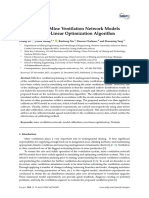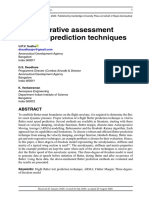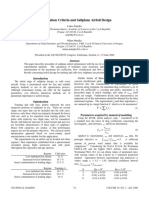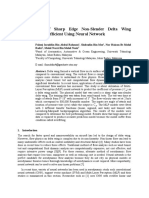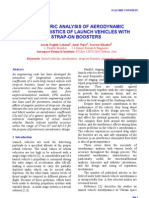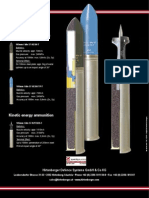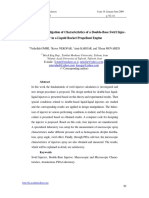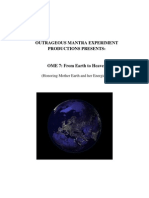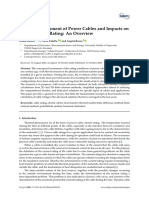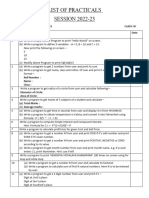D R A G Coefficient Curve Identification of Projectiles From Flight Tests Via Optimal Dynamic Fitting 1
D R A G Coefficient Curve Identification of Projectiles From Flight Tests Via Optimal Dynamic Fitting 1
Uploaded by
yararaCopyright:
Available Formats
D R A G Coefficient Curve Identification of Projectiles From Flight Tests Via Optimal Dynamic Fitting 1
D R A G Coefficient Curve Identification of Projectiles From Flight Tests Via Optimal Dynamic Fitting 1
Uploaded by
yararaOriginal Title
Copyright
Available Formats
Share this document
Did you find this document useful?
Is this content inappropriate?
Copyright:
Available Formats
D R A G Coefficient Curve Identification of Projectiles From Flight Tests Via Optimal Dynamic Fitting 1
D R A G Coefficient Curve Identification of Projectiles From Flight Tests Via Optimal Dynamic Fitting 1
Uploaded by
yararaCopyright:
Available Formats
Pergamon
PII0967-0661 (97)00044-0
Control Eng. Practice, Vol. 5, No. 5, pp. 627-636, 1997
Copyri ght 1997 Elsevier Science Ltd
Printed in Great Britain. All fi ght s reserved
0967-0661/ 97 $17. 00 + 0. 00
DRAG COEFFI CI ENT CURVE I DENTI FI CATI ON OF PROJECTI LES
FROM FLI GHT TESTS VI A OPTI MAL DYNAMI C FI TTI NG 1
Yangquan Chen*, Changyun Wen*, Zhiming Gong* and Mingxuan Sun**
*School of Electrical and Electronic Engineering, Nanyang Technological University, Nanyang Avenue, Singapore 639798,
Republic of Singapore (ecywen@ntuvax.ntu.ac.sg)
**Department of Electrical Engineering, Xi'an Institute of Technology, Xi'an 7]0032, P.R. China
(Received March 1996; in final form March 1997)
Abst ract : Extracting a projectile' s optimally fitting drag coefficient curve CaI ( M)
from flight testing dat a is considered as an optimal tracking control problem
( OTCP) , where CdI ( M) is regarded as the control profile, while the flight testing
dat a is t he desired trajectory t o be optimally tracked. Cubic splines with deficiency
number 2, which can guarantee t he continuity and fitting flexibility of CdI ( M) ,
are employed t o parametrize t he Cdt ( M) . This functional minimization problem
( OTCP) can t hen be converted into a multivariable parametric minimization one.
The st andard Newton-Raphson iteration is formulated. A quasi-Newton-Raphson
iterative scheme is proposed t o reduce the cost of comput at i on by half, and performs
a near-second-order convergence by using t he first-order gradient only. A further
simplification is proposed by using t he approximated Hamiltonian function, which
cut s t he computing cost by half once more. A practical testing data-reduction
result is presented t o show t hat the optimal dynamic fitting is a useful scheme for
aerodynamic coefficient curve identification. Copyright 1997 Elsevier Science Lt d
Ke y wo r d s : Optimal control, dat a reduction, curve fitting, identification.
1. ~ T R O D U C T I O N
In exterior ballistics, t he most i mport ant fac-
t or concerned is t he aerodynamic drag coefficient
curve Cd( M) , which plays a critical role in the
firing t abl e generation. An accurate firing table
is vital t o t he accuracy of t he artillery attacks.
Although one can use wind tunnel tests or nu-
merical aerod3marnic propert y prediction codes
t o obt ai n t he aerodynamic propert y curve of a
projectile, t he results suffer from t he errors intro-
duced by interference from t he wind tunnel wall
1 This paper is partially supported by the National Science
Foundation of China under project no. 69404004.
or impractical assumptions made in numerical
modeling, and so on. Therefore, identifying t he
aerodynamic properties of real or full-scale flying
vehicles from flight testing dat a is an i mport ant
area in modern flight dynamics (Chapman and
Kirk, 1970; Lieske and Mackenzie, 1972; Bartel-
son, 1975; Ross, 1975; Eulrich and Rynaski, 1975;
Williamson, 1980; Gupt a and Illif, 1982; Frat t er
and Stengel, 1983; Anderson and Vincent, 1985;
Jiang and Chen, 1986; Chen et al., 1992; Linse and
Stengel, 1994). Essentially, this is a combination
of modern control t heory and flight dynamics. Be-
cause, in most of the proving grounds, t he doppler
tracking radar such as TEtLMA OPOS DR-582 is
becoming a common item of equipment, finding
627
628 Yangquan Chen et al.
the best means of utilizing the measured data is
receiving a lot of attention. This paper concen-
trates on the identification of a single aerodynamic
drag coefficient curve of an artillery projectile
from velocity data of flight tests measured by
tracking radar.
The easiest and most straightforward method is to
apply the direct numerical differentiation (DND)
method. The results obtained in this way cannot
be applied directly, as measurement noise will be
amplified during the differentiation of the mea-
sured velocity. However, the result is still useful in
the sense that it can provide a reasonable initial
trial for other advanced approaches. To get the
result more accurately, a differential correction
method was introduced in (Chapman and Kirk,
1970) by incorporating the ballistic model into a
Newton-Raphson-like iteration. It is worth point-
ing out that the existing literature only concen-
trates on aerodynamic coefficient extraction by
parameter identification, see for example (Bartel-
son, 1975; Williamson, 1980; Gupta and Illif, 1982;
Fratter and Stengel, 1983; Larimore et al., 1985;
Illif, 1985, 1989; Anderson and Vincent, 1985).
Surveys on the parametric identification can be
found in (Illif and Maine, 1986; Peter, 1989). In
fact, from the intrinsic characteristics of aero-
dynamics (Tobak and Schiff, 1981), aerodynamic
property curves (Mach history) can be regarded
as deterministic control profiles, and aerodynamic
property identification can be considered as an
optimal tracking control problem (OTCP) where
the collected testing data are the desired trajec-
tories to be optimally tracked. However, this kind
of profile optimization problem cannot be directly
solved by numerical methods in standard optimal
control because it is a singular optimal control
problem. Moreover, it has also been found that
the aerodynamic property time history cannot be
directly applied (Chen et al., 1992; Chen and Dou,
1993a). This is because the resulting aerodynamic
coefficient may be a multi-valued function of the
Mach number. This is inconsistent with the theory
of aerodynamics, when the ballistic trajectory of a
flight test has an ascending part and a descending
part. Thus, solving this singular optimal control
profile problem provides the motivation to explore
new schemes.
The idea of a scheme termed optimal dynamic
fitting, developed by Chen et al. (1992), can be
applied to solve the OTCP mentioned above. Its
fundamental approach is to convert the functional
minimization problem into a multivariable para-
metric minimization problem, where the control
profile is appropriately parametrized and then
an effective optimization algorithm is applied.
A similar idea was also used in (Messner and
Horowitz, 1993), where, through an integral rep-
resentation of the control profile, the functional
basis is considered as the regressor and the influ-
ence function is regarded as "parameters" to be
optimally sought. In this paper, the control pro-
file Cd/(M) is parametrized by cubic splines with
deficiency number 2. Thus the first-order deriva-
tive of CdI(M) is guaranteed to be continuous.
To search for the optimal parameters, a standard
Newton-Raphson iteration is applied. To reduce
the complexity of the algorithm, an idea termed
"quasi-Newton-Raphson iteration" is introduced.
This can achieve near-second-order convergence
and cut the computing cost by half even if only
the first-order gradient is used. By utilizing the
approximated Hamiltonian function, the comput-
ing cost can be further reduced by half or more.
In addition, the initial system states for flight
testing, which may be uncertain or inaccurate,
can be easily identified or corrected, together with
the optimal dynamic fitting. As real flight testing
was conducted to obtain the data for aerodynamic
curve identification, the authors believe that the
results obtained are rather convincing in applica-
tions including the verification and improvement
of design objectives, validation of computational
aerodynamic property prediction codes, and so on.
It should also be pointed out that, from the
aerodynamic point of view, the identified Cu/(M)
curve cannot be taken as a zero lift drag coeffi-
cient curve or an incidence induced drag coeffi-
cient curve. The CdI(M) is just the fitting drag
coe1~icient curve with respect to the trajectory
model employed, which comprehensively reflects
the effects of zero lift drag and the drag induced
by the angular motion around the center of mass.
Because the generation of the firing table is mainly
based on a single ballistic coefficient, a drag law,
and some fitting factors, more accurate firing ta-
bles can be produced when the CdI(M) identified
in this paper is utilized directly.
The remaining parts of this paper are organized
as follows. The problem formulation is given in
Section 2. Two elements of the optimal dynamic
fitting application, i.e., cubic spline parametriza-
tion and Newton-Raphson iteration, are presented
in Section 3. Some simplifications utilized in this
optimal dynamic fitting problem, i.e., the quasi-
Newton-Raphson scheme and the approximate
Hamiltonian function method, are introduced in
Section 4. The correction of inaccurate initial con-
ditions is discussed in Section 5. In Section 6, an
actual flight-testing data-reduction result is given
to show the effectiveness of the dynamic fitting
method. Section 7 concludes this paper. A com-
plete set of actual flight testing data, as well as the
Curve Identification of Projectiles from Flight Tests 629
testing conditions, are given in the APPENDIX. model (1), which is regarded as the control profile.
The Mach number M ~= V / a , where a is the local
sonic speed.
2. PROBLEM FORMULATION
For brevity, a 3-DOF point mass ballistic model
is used in this paper. A more complete ballis-
tic model (Chen, 1990a, b, 1991) may be used if
other aerodynamic coefficients are available, and
the method presented here can still be applied.
Suppose t hat at time t, the position of the pro-
jectile P in the earth coordinate system (ECS) is
[x(t), y ( t ) , z ( t ) ] T , and its relative velocity vector u
w.r.t. ECS is [ u z ( t ) , u ~ ( t ) , Uz (t)] T. The position of
the radar R in ECS is [Xr(t), y ~ ( t ) , Z r ( t ) ] T , which
is known from the testing setup as shown in Fig. 1.
t=t 0
)
j /
/ . /
S j
, ~ bal l i sti c trajectory
/ ' Z .,,.,..,.c,,..
acki ng radar R ' , [zv-, y r , z r ] known.
Fig. 1. Illustration of Doppler Radar Tracking
The 3-DOF point mass trajectory model can be
described by nonlinear state space equations as
follows:
I ~ = n(x(t),cd,) = ~-~(.. -~.)c~
,:ra_:rt~
u~ =h(x(o,c~) =- ~ (~ - ~)c~
(1)
= h ( z c t ) , c ~ ) = u ~
= / s ( x ( t ) , cd,) = , ~
where X ( t ) = [ u z , u y , U z , X , y , z ] T is the state
vector of system (1); t E [0,T], T is known
and the initial state X(0) may not be exactly
known; g is the gravitational acceleration; wx, wz
are the wind components in ECS known from
meteorological measurements; V is projectile's
relative velocity w.r.t, the wind and
v= ~/(~,- ~)2+~+(~- ~): ; ( 2 )
p is the air density; s = ~rd2/4 is the reference area
of the projectile and d is the projectile's diameter;
m is the mass of the projectile; C 4 ? ( M ) is the
fitting drag coefficient curve w.r.t, the trajectory
The drag coefficient C4f in the 3-DOF point-
mass model (1) should be the combined effects
of the zero-lift drag coefficient Cdo and the angle-
of-attack induced drag coefficient Cdo2, i.e.,
Ca/ = C~ o + Cd,2 a2
where a is the angle of attack. To accurately
predict a, all aerodynamic coefficients must be
exactly known and a full rigid-body 6-DOF model
(Chen, 1991) should be used. In this situation, the
curve identification methods of this paper are still
applicable. However, the computational cost will
be unnecessarily high. As far as the aerodynamic
identification problem of this paper is concerned, a
full rigid-body 6-DOF model is unnecessary, based
on the following observations:
O1) From the causality considerations, the veloc-
ity is directly affected by drag force while the
motion around center of mass has an indirect
effect on the velocity.
02) For a spin-stabilized projectile, the maximal
angle of attack along the whole ballistic tra-
jectory is normally small, e.g., around 10 .
It is worth stressing again that the above "control
profile" C ~ I ( M ) cannot only be taken as a zero
lift drag coefficient curve or an incidence-induced
drag coefficient curve. The Cd~ (M) is the f i t t i n g
d r a g c o e j ~ c i e n t c u r v e with respect to the ballistic
model used. Because the C4 (M) comprehensively
reflects the effects of zero lift drag and the drag in-
duced by the angular motion around the center of
mass, the 3-DOF point mass model (1) describes
the projectile's movement better than the case
when the C d / ( M ) is replaced by a ballistic factor.
Denote r ( t ) a s the distance between the tracking
radar R and the projectile P, and v r ( t ) a s the
velocity data, measured using doppler radar.
v ~ ( t ) = ( t ) ( 3 )
To solve the optimization problem conveniently,
the projectile's tangentia.l velocity u must be
transformed into v d , which is in the doppler
--+
radar' s radial sense, i.e., the R P direction. Let
G , ~ , ~ z ] = [ x - x r , y - y r , z - z r ] . ( 4 )
Then
r = ~ / r ~ + r ~ + ~ ( 5 )
a n d Vd is given to be
630 Yangquan Chen et al.
va = + uyr y + ( 6 )
which has t he same implication as t hat of vr(t).
Equation (6) can be taken as the out put equation
of system (1). Define the functional performance
index as
T
J[ CaI ( M) ] = f L(Cdt(M),X(t),t)dt (7)
where
L ( O4 t ( M) , X ( t ) , t) = (va(t ) - vr(t )): ,
and assume a free terminal condition. It can be
seen t hat equations (1), (6), and (7) formulate
an optimal tracking control problem (OTCP),
where t he doppler radar measured velocity dat a
v~(t ) is t he desired t raj ect ory t o be optimally
tracked, and t he f i t t i ng drag coe O~cient curve
C4 (M) is t he cont rol profile t o be determined by
miniraizing J[Cal (M)]. The Hamiltonian function
H( C d I ( M) , X ( t ) , t ) is
H = L + A T f (8)
where L is given in (7) and f = [ f l , f 2 , ' " , f6] T i s
defined in (1). A -- [)q, )~2,""", ~ 6 ] T i s the co-state
vector which can be obtained from
_~ OH OL T Of
OX = OX A ~-~, (A(tl) = 0). (9)
Fig. 2. ()ptimal dynamic fitting met hod
3.1 Par amet r i z at i on of Ca I ( M)
Cubic splines with deficiency number 2 are used
to parametrize the control profile Cd I ( M) . The
idea of Hermite interpolation is employed. Sup-
pose t hat t he C~t ( M) , where M E [Mo, MI ] , and
[Mo, MI ] is divided into n segments with n + 1
knots M0 = M1 < M2 < . -. < Mn < Mn+l =
M I. [Mo, MI ] can be estimated to cover t he prac-
tical Mach range. Denote f i , di as t he function
value and the first-order derivative of C4 t ( M)
at the i-th knot Mi respectively. Consider the
interval [Mi, Mi+l] and suppose M E [Mi , Mi+x].
Then a Hermite-type polynomial C4 , (M) can be
uniquely determined by f i , di , f i +l , di +l , i.e.,
Obviously, the above OTCP is a singular one
because OH/ OC4f does not explicitly contain the
Cag term. Difficulties will arise in the numeri-
cal comput at i on for this singular optimal control
problem (SOCP). Furthermore, the correction of
inaccurate X(0) will not be easily made using the
st andard numerical methods for solving optimal
control problems. The optimal dynamic fitting
met hod proposed in the following section can
overcome t he above problems.
C4h (M) = [71 (Ti), 72 (7i), 9'3 (ri), 7t(r~)]
[fi, di, +1, di+l] T
= [ O t l i , O~2i, O t 3 i , a 4 i ] [ 1 , M, M 2, M3 ] T
= [~'li,~2i,~3i,,~4,][1,ri,T~,'r~] :r (i0)
where 7"i = ( M - Mi ) / h i , hi = Mi+l - Mi.
Obviously Ti E [0, 1]. One can also easily get
A1[131~,/32{,/33i, 134i] T = [f i , di , f i +l , di+y] T (11)
3. OPTI MAL DYNAMIC FI TTI NG
The optimal dynamic fitting met hod can be de-
scribed in Fig. 2.
To apply t he dynamic fitting method, the first
thing t o do is t o determine the parametrization
of t he control profile. Then an efficient parameter-
searching met hod is t o be employed. In this paper,
t he control profile is parametrized by using cubic
splines with deficiency number 2, and the para-
metric searching metho~l is the Newton-Raphson
iteration, which are described in detail as follows.
where
Then,
A 1 =
1 0 0 0
0 hi -1 0 0
1 1 1 1
0 h~ -1 2h~ -1 3h~ -1
[ o j h~ 0
Ai-1 = - 2hi 3 - h i "
hi - hi
Curve Identification of Projectiles from Flight Tests
631
[
, n ( - r d ] T
= ~ ( ~ , ) / = [ 1 , . r , , v ~ , ~ - a l A 1 1
~ 3 ( ~ * ) /
~4(n) J
r 1 - 3 ~ r : +2 v 2 I T
/ h , O ' , - 2 r ? + ' 4 )
= / 3 ~ ' ~ - 2 T ~ . ( 1 2 )
L h , ( - ~ ? + ~ ? )
whe r e C2/ _ z ---- f i , C2/ ---- d,, (i = 1 , 2 , . . . , n + 1).
The functional minimization problem
, m J [ C ~ ]
C,q
can t hen be converted into a multivaxiable para-
metric optimization problem, i.e.
rain J[CdI ].
C
Clearly,
L~I*, 32*, 32i , 34i] T "-- A2[oq/, 0~2i, ot3,, cl4,] T (13)
where
A2 =
hi 2h, M, 3hi M~ l
o '
0 0 h i J
i - h i ' l M * h~-2 M? - h i -3 M?
-2hi -2M, 3hTs aM3
A~ 1 = h~
-h~- -3hi -3M,
0 0 h i -3
So, t he curve CdI ( M) E C l [ Mo , Mf ] , i.e., CdI(M)
is a smoot h function. As t he number of segments
n and t he knots can be determined by t he user,
sufficient flexibility of t he parametric description
of C@( M) can be guaranteed. On t he other hand,
a spline description with low-order smoothness
has fewer paramet ers t o be searched, and is an
effective description met hod in most applications.
Moreover, explicit expressions in t erms of either
M or ri can be readily obtained from (10)-(13).
For example, when M is used, for M [Mi, Mi+I],
we have
Cd& (M) = [ a l i , Ot2*, O~3*, a4,][1, M, M 2, M3 ] T ,
where, from ( 1 0 ) - ( 1 3 ) ,
[ a l , , Ot2i, C~3i, a4, ] =
[f,, d,, f*+l, d*+I](A11)T(A~X) T.
The detailed form can be easily obtained as fol-
lows:
( az, = 31, - h? l M ,32, + h? 2M 2& , - h-;3M2~4*
a2, -- h7~132, - 2h'~Md33~ + 3hi-3Ma34,
a3i = -_h~232, - 3hr, aM,34*
a4* = h~- 34*
{
31,
32,
3a*
3 * *
= ~
= hi d,
= - 3 f , - 2h~d, + 3f, +l - h,di+l
= 2fi + hi d, - 2f,+z + hid~+l
Now denote
C T = [Cl, C2," " ' , C2n+2] (14)
A class of direct search methods can be used t o
solve t he above problem. However, this will be less
effective when n is large. In most applications,
initial guess at t he control profile C( ) ( M) a n
can be obtained within a feasible region. Thus,
t he Newton-Raphson iteration is preferred and
OJ/Oci and OuJ/OciOcj ( i , j = 1 , 2 , . . . , 2 n + 2)
are t o be determined. In what follows, OJ/Oc~ is
denoted by ~, for brevity.
3.2 Neurton-Raphson Iteration
From t he optimal control theory, t he optimality
condition of t he OTCP is
OH OL OAr f
- - = - - + - - = 0 . ( 1 5 )
oc~ oc~ oc~
From (15),
OL O~TI
= - ~ ( 1 6 )
oc~ oc~
i.e.,
OL O A T / O C d f
o
Oc, OCd! Oc~
( 1 7 )
So, integrating (17) from 0 to T w.r.t, t i me t yields
T
oc~
0
T
f ps V r . ,
= - - - ~ mL A t l u z - - Wz) + )~2U v -t-
0
~ 3 ( u = - w=)] 0 a ~ dr.
Noticing t hat
OV u= - w= Ou= u v Ouy
oc--: - - - T - - - o--~ + v Oc~ + - -
(18)
Uz -- tOz 0~z
V Oc~
and ignoring t he effect of Op/ ay,
T
O~i 02 J ps V OV . O)~x ,
- - = + V ~ e j )
o
632 Y angquan Chen et al.
. OV h OA2
- + + v y z ) u ,
J
-I-(~ Cj/ ~ 3 -I- V )(U z - Wz) q- h l (9U._._~x
Ocj
Ou~ Ou~ OCdz
+ A2 ~ c j + h:3~---cj ]---O--~-ici dt (19)
where i , j = 1 , 2 , . . . , 2 n + 2. Part i al differentia-
tion of (1) w. r. t, c a (j = 1 , 2 , . . . , 2 n + 2) gives
( o x o / , ,0
dt 0c i ) = 0~cj' = = 0 . (20)
Similarly, by part i al l y differentiating (9) w.r.t.
cj ( j = 1, 2 , - . . , 2n + 2), t he d. e. ' s of OA/Oc~ can
be obt ai ned,
d . 0 h ) _ OH 0 h i = 0 . (21)
d--t(~ cj OX' Ocj t=tl
By i nt egrat i ng (1) and (20) si mul t aneousl y from 0
t o T (wi t h t he initial condi t i ons given in (1) and
(20) respect i vel y), t hen i nt egrat i ng (9) and (21)
from T t o 0 (wi t h t he final condi t i ons given in (9)
and (21) respect i vel y), 0~ , / 0c i and ~ , in (18) and
(19) can be comput ed easily by a pr oper quadra-
t ur e al gori t hm. Therefore, t he Newt on- Raphson
i t erat i on can be appl i ed, i.e.,
{
C(k+ x) = C (k) + 6C (k)
A( k)6C (k) = B (~)
(22)
where k is t he i t erat i on number; 6C (k) is t he
opt i mal i ncrement of C (~) at t he k-t h iteration.
Let aLj and b, t he el ement s of mat ri ces A (k) and
B (k) respect i vel y; it is obser ved t hat
a,,j = Oc, ' (23)
b~ = -~oi, i , j = l , 2 , . . . , 2 n + 2.
At t ent i on must be pai d t o t he cal cul at i on of
OC4t/Oci. From (10) and (12), OCdl/Oc, does not
equal 0 in [Mk, M~ +I] only, where k = [(i + 1)/ 2] ,
and [.] denot es an i nt eger t r uncat i ng operat i on,
i.e.,
0ca
0, M [Mk, Mk+l ], Vi;
= 71(rk), M E [ Mk, Mk+l ] , i is odd;
72(rk), M E [Mk, Mk+l ] , i is even.
is known from t he causal i t y rel at i ons t hat in t he
forward i nt egrat i on of (1) and (20)
(0x)
dt Oc, =0, i = 2k + 3, 2k +4 , . . . , 2 n + 2 (24)
while in t he backwar d i nt egrat i on of (9) and (21)
d_(0h)
dt Oc, = 0 ' i = 1 , 2 , . . . , 2 k - 2 . (25)
Similarly, if t he current Mach number M bel ongs
t o t he ascendi ng t raj ect ory, it is necessary t o set
d OX
~ ( ~ - - ~ ) = 0, i = 1 , 2 , . - - , 2 k - 2 (26)
in t he forward i nt egrat i on of (1) and (20), and
d . 0A)
d-t(~c~c, = 0 , i =2 k +3 , 2 k +4 , . . . , 2 n +2 (27)
in t he backwar d i nt egrat i on of (9) and (21).
4. SOME PRACTI CAL SI MPLI FI CATI ONS
The Newt on- Raphson i t erat i on (22) will converge
rapi dl y in a second-order sense if a pr oper initial
poi nt C () can be chosen. A rough but reason-
abl e C( ) ( M) can be obt ai ned from (1) by di-
rect numerical differentiation (DND), but larger
errors will be i nt roduced. So, t o get this p(0) wi t h
smaller errors, dat a-fi t t i ng-based DND t echni ques
can be used wi t h care. The met hod and soft ware
of (Chen and Dou, 1991) are helpful.
From t he l ast section, it is not ed t hat 12(n + 1) +
6 d.e.' s are t o be i nt egrat ed in t he forward or
t he backward direction, i.e., for Newt on- Raphson
i t erat i on (22), t here is a t ot al of 24( n+ 1) + 12 d. e. ' s
t o be i nt egrat ed. Wi t h a larger n, t he bur densome
comput at i on in forward or backwar d i nt egrat i on
is obvious. Based on t he fact t hat , as di scussed be-
fore, a pr oper C () can be obt ai ned by t he met hod
descri bed in this paper, some simplifications can
be made t o reduce t he comput at i onal cost. One
i dea is t o avoid t he backwar d i nt egrat i on pass.
Anot her way is t o use an appr oxi mat ed Hami l t o-
nian function.
Fur t her mor e, it is known t hat t he M( t ) curve is
usual l y a U - t ype, where t he mi ni mal Mach num-
ber poi nt cor r esponds t o t he t r aj ect or y apogee.
Thus, when CaI ( M) is par amet r i zed w.r.t. M, one
must consi der t he ascendi ng and descendi ng par t s
of a ballistic t r aj ect or y separ at el y in t he process
of forward and backwar d i nt egrat i on. Suppose
M E [Mk, M~ +I]. If t he current Mach number
M is in t he descendi ng par t of t he t raj ect ory, it
4.1 Quasi-Newton-Raph son Iteration
To avoid t he backwar d pass, by t aki ng a par t i al
deri vat i ve w.r.t, c, di rect l y in (7),
T
oJ _ 2 f ( v ( t ) - vr ( t) ) Ova( t) dt ( 2 8 )
~' - ~ Oci
Curve Identification of Projectiles from Flight Tests
633
where Ovd( t ) / Oci can be determined from (6) and
from OX ( t ) / Oc i . From (28), let
which can be regarded as the desired output. With
OOv/OCdl ,~ O, OV/ Ou ~ 1,
T
02_ A Ova(t)
ocj 2 [ 2 d r .
J Oci Oc~
0
(29)
)X = - O [-I / O u
= - 2( u - ut ) + A p s V C a l / m , A(T) = 0, (32)
Replacing equations (18) and (19) with (28)
and (29) respectively, forms the quasi-Newton-
Raphson iteration which was called di f f erent i al
correct i on in (Chapman and Kirk, 1970). In (29),
the terms related to the second-order partial
derivatives, i.e., 2( v d( t ) --vr(t))O2Vd/OCiOCj, are
ignored. Since C () can be properly chosen to
make the iteration converge, the effect of these
ignored terms will be smaller and smaller, and the
convergence approaches the second-order sense.
Although this simplification needs a few more iter-
ations than t hat of iteration (22), the computing
cost can be cut down by half because the back-
ward integration is not required. Thus, the above
quasi-Newton-Raphson iteration is applicable and
attractive.
i~ = O[-I/OA = ps V2, ~ sin(0v), (33)
- 2 m ~ a / - g
T
= [ .s v xoc. dr,
J 2 m Oci
0
(34)
Ocpi = f
Oc~
ps OCat [V 2 05~
2m 0K ~ + 2~Y ]dr.(35)
From (32) and (33), the d.e.'s for OA/ Oej and
Ou/ Ocj can be written as
d Ou _ ps 20Cdl
dt Oci 2 m I V ~ + 2 Cd I V ] (36)
The explicit assumption used in this scheme is
that a proper C () could be chosen to make the
iteration convergent. In the specific problem of
this paper, this assumption is feasible in practice
as discussed in Section 6.
4.2 Usi ng an appr ox i mat e d Ha mi l t o n i a n f u n c t i o n
The main starting point for utilizing an approxi-
mated Hamiltonian function to simplify the com-
putation is based on the simple fact that velocity
is mainly affected by aerodynamic drag. By in-
troducing the d o mi n a n t s t at e u, one can re-write
the Hamiltonian function (8) in an approximated
form as
[1 = L + A { - P~- V2Cdl - 9s i n( Or ) } (30)
Am
where L zx ( ut - u) 2, A is a co-state variable,
Ov = tan -1 ( u u / u x ) , and ut is the tangential veloc-
ity along the ballistic trajectory which is obtained
by a transformation from the actual radar mea-
--4
sured velocity, vr, which is in a radial sense ( R P ) .
The cost function is defined here in terms of the
tangential velocity of the ballistic trajectory. This
is because in this case such a cost function results
in simpler mathematical derivations. However, the
result would be the same if the cost function were
re-defined in the radial sense, as in (7).
Fr o m (6),
, r ~ u ~ r ~ u ~ r ~ u x vd ( 3I )
ut = V r ( - - - - + - - - - + ) = V r - - ,
r u r u r u u
d OX_ 20u pS[xVOC - Ou
dt Oei Oci + - - +
m Oc~ ~C~t
0 i
+ V C dt -8-~ l . (371
The standard Newton-P~phson iteration can be
applied similarly by the forward integration of
(1) and (36) with Ou/Oci[t=o = 0, and then by
the backward integration of (32) and (37) with
OA/Oci[t=T = O. The total number of the d.e.'s to
be integrated in this scheme is 4n + 11, which is
less than the half of the quantity (12n + 18) for
the quasi-Newton-Raphson iteration. If the idea of
quasi-Newton-Raphson iteration is combined with
this approximated Hamiltonian function scheme,
the total number of d.e.'s will be 2n + 6. This is
achieved by replacing (34) and (35) with
T
~oi = 2(u - u t ) w - - d t (38)
OCi
0
T
O~oi Ou Ou
2 Ndt
0
where only forward integrations of (1) and (36)
are required, as discussed in Section 4.1.
The explicit assumption used in this simplification
is based on the simple intuition t hat the velocity is
mainly affected by aerodynamic drag. If a quasi-
Newton-Raphson iteration is used, a similar as-
sumption on C () should be observed as discussed
in Section 4.1.
634 Yangquan Chen et al.
5. CORRECTION OF INACCURATE X(0)
In most optimal tracking control problems, the
initial state X(0) is assumed to be known ex-
actly. In many real applications, this is not the
case. Because the accuracy of X(0) will directly
affect the final optimal solution, it is reasonable
to take the inaccurate initial states as the design
parameters. To take the X(0) as design param-
eters can be easily carried out in the proposed
optimal dynamic fitting method. In this paper, the
approximated initial X(0) can readily be obtained
from the measured data and the testing setup.
To apply the quasi-Newton-P~phson method, the
procedure for optimizing X(0) is similar to that
for C T. Referring to (20), 36 d.e.'s related to X(0)
can similarly be determined. The relevant initial
integration conditions must be set to 0 except the
following
Ox/Oxolt=to = 1, OY/OYolt=to = 1,
O z / a z o l = t o = 1 , = 1 , ( 4 0 )
= 1 , O u z l O , z o l = o = 1 ,
where OCdl/OX(O) is ignored. For the simplified
schemes introduced in the above section, the ini-
tial state corrections can be made accordingly.
It should be pointed out that if some of the initial
states are not directly related to the final solution
and not sensitive to the performance index, one
must then determine carefully, from the concept
of fitting flexibility, which initial states are to
be taken as the design parameters. This is an
important issue in practical applications.
guarantee the "fitting flexibility", at least 2 seg-
ments (3 knots) should be used. In this paper, the
number of segments n is 2 with 3 knots. However,
a larger n can be applied but will not always be
desirable because this will increase the computa-
tion cost and cause the "over-fitting" problem.
It has been verified that the four schemes, i.e.,
the standard Newton-Raphson iteration (22),
the quasi-Newton-Raphson version, the standard
Newton-Raphson iteration utilizing the approxi-
mated Hamiltonian and its quasi-Newton-Raphson
form, all have the same converged C~g(M) which
is plotted as a solid line in Fig. 3. The computa-
tional cost comparisons of the four schemes sup-
port the arguments regarding the computational
simplifications in Section 4. In Fig. 3, the curve
shown as a dash-dotted line is the result of the
work described in (Chen and Dou, 1993b).
0.4
0.35
0,3
~ - 0.25
. ~ 0 . 2
~ 0 . 1 5
0.1
0.05
t~
i
by oplimal dynamic filling
. . . . . . . . . . b y iteralive learning identilica~n
M a d ) n u m l ~ M
Fig. 3. Comparison of the results of optimal dy-
namic fitting and iterative learning identifi-
cation (Chen and Dou, 1993b)
6. RESULTS FROM ACTUAL FLIGHT
TESTING DATA
The main purpose of the flight tests is to finally
measure the aerodynamic drag coefficient curve of
the artillery projectiles. Several tests were carried
out under different firing conditions. The identi-
fied curves are similar if the angle of attack along
the trajectory is small. One of the identified curves
is presented here. A set of complete flight testing
data is given in the APPENDIX.
To simplify the choice of C () , a constant C(d~ ) (M)
is assumed which means only one parameter to
be determined. For a spin-stabilized projectile,
C()(M) as 0.3 is reasonable. Thus, the choosing
= o . 3 o , o ) ( i =
initial parameters are set as -2i-1
1, 2,3). It should be pointed out that, from the
Mach range of this set of flight testing data, to
It can be clearly observed that the result of this
paper is a fitting of (Chen and Dou, 1993b). The
correctness of the identified result can be observed
from Fig. 4, where the nominal zero-lift drag
coefficient Cdo(M) and the angle of attack induced
drag coefficient Cda2(M) are given. Clearly, the
identified CdI(M) comprehensively reflects the
effects of the air on the motion of the center of
the projectile's mass, and the motion around the
center of mass. Approximately,
Cdl (M) ~ Cdo(M) + Cda2(M)a 2,
where a is the angle of attack. It can be estimated
from Fig. 3 and Fig. 4 that the angle of attack
at the maximum point in C4f ( M ) is around 9 .
This observation also verified the 02) in Section 2,
which implies that, for the problem of identifying
the drag coefficient curve from radar measured
velocity data, a point-mass 3-DOF model (1) is
Curve Identification of Projectiles from Flight Tests 635
sufficient. REFERENCES
0 . ~
0.~
' ~ 0 . 1 5
0.1
0.0~
. . . . . . . . . . _ . _ .
/"
n o n W d inck:tonco I ~ t u c o d d mo c o e t , Cdo2AM)r'zo.
. . . . . . . . . nominal zem-41ft cling c o ~ . , OdO(Id)
Mat h m m ~ M
Fig. 4. Nominal drag coefficients: zero-lift drag co-
efficient Cdo(M) and incidence induced drag
coefficient Cda2 ( M)
7. CONCLUSION
The proposed optimal dynamic fitting met hod
has been successfully applied to an optimal track-
ing control problem, namel y aerodynamic prop-
ert y curve identification from flight testing data.
Cubic splines with deficiency 2 are employed as
a paramet ri c description st ruct ure for t he con-
trol profile (Mach history), which guarantees t he
smoothness of t he control profile. The problem
is t hen converted t o a multivariable parametric
minimization one, and is solved by t he st andard
Newton-Raphson iteration. To reduce t he cost of
t he computation, a quasi-Newton-Raphson itera-
tion is proposed, and t he cost is effectively reduced
by half, using this method. Further simplifications
of t he problem are introduced by using an ap-
proximated Hamiltouian of t he dominant variable,
which cuts t he computing cost by half once more.
Also, inaccurate initial states can easily be cor-
rected. The optimal fitting drag coefficient curve
obtained is apparent l y bet t er t han t he commonly
used fitting ballistic factor. Thus, a more accurate
firing table could t hen be produced. Furthermore,
t he met hod of this paper supplies an effective way
of solving a wider class of singular optimal control
problems. Results of practical flight testing dat a
reduction indicate t he effectiveness of t he methods
proposed in this paper.
ACKNOWLEDGEMENTS
The authors are grateful t o t he reviewers' encour-
agement, patience and technical insights.
Anderson, L. C. and J. H. Vincent (1985). Ap-
plication of system identification to aircraft
flight test data. In ' Proceedings of t he 24th
IEEE Conference on Decision and Control' .
Fort Landerdaie, FL, USA. pp. 1929-1931.
Bartelson, N. (1975). A met hod for determination
of aerodynamic drag by doppler data. In ' Proc.
of t he First Int. Ballistics Symp.' . Orlando,
USA.
Chapman, G. T. and D. B. Kirk (1970). ' A
met hod for extracting aerodynamic coefficients
from fr~e flight dat a' . AI AA Journal.
Chen, Y. (1990a). ' Researches on t raj ect ory
prediction models and software for spin-
stabilized projectiles (I): Aut omat i c model-
switching t raj ect ory prediction met hod' . Pro-
jectile and Rocket Fascicule of Acta Armamen-
tarii 1990(3), 1-7 (in Chinese).
Chen, Y. (1990b). ' Researches on t raj ect ory pre-
diction models and software for spin-stabilized
projectiles (II): Studies on t raj ect ory prediction
model reduction' . Projectile and Rocket Fasci-
cule of Acta Armamentarii 1990(4), 1-11 (in
Chinese).
Chen, Y. (1991). ' Researches on t raj ect ory pre-
diction models and software for spin-stabilized
projectiles (III): A new rigid body 6-dof model
for t raj ect ory prediction of unguided spin mis-
siles'. Projectile and Rocket Fascicule of Acta
Armamentarii 1991(1), 1-10 (in Chinese).
Chen, Y. and H. Dou (1991). ' Dat a fitting al-
gorithm and general purpose software by con-
strained multi-staged polynomials with differ-
ent orders' . Aerodynamic Experiment and Mea-
surement Control 5(3), 78-86 (in Chinese).
Chen, Y. and H. Dou (1993a). ' Researches on t he
optimal control solution of identifying fitting
drag coefficient curve from radar measured ve-
locity data' . Aerodynamic Experiment and Mea-
surement Control 1993(2), 81-89 (in Chinese).
Chen, Y. and H. Dou (1993b). Robust curve
identification by iterative learning. In ' Proc. of
t he First Chinese World Congress on Intelli-
gent Control and Intelligent Aut omat i on (CWC
ICIA' 93)' . Beijing, China. pp. 1973-1980.
Chen, Y., D. Lu, H. Dou and Y. Qing (1992).
Optimal dynamic fitting and identification of
aerobomb' s fitting drag coefficient curve. In
' Proc. of t he First I EEE Conf. on Control
Applications' . Dayton, Ohio, USA. pp. 853-858.
Eulrich, B. J. and E. G. Rynaski (1975). 'Identifi-
cation of nonlinear aerodynamic stability and
control parameters at high angle of at t ack' .
A GARD Methods for Aircraft State and Param-
eter Identification pp. 1-15.
Fratter, C. and R. F. Stengel (1983). 'Identifi-
cation of aerodynamic coefficients using flight
testing data' . AI AA Paper No. 83-~099.
636
Yangquan Chen et al.
Gupt a, N. K. and K. W. Illif (1982). ' Identification
of aerodynamic indicial functions using flight
dat a' . AI AA Paper 82-1375.
Illif, K. W. (1985). ' Extraction of aerody-
namic paramet ers for aircraft at extreme flight
conditions' . NASA- TM- 86730 H-1290 NAS
1.15:86730 AGARD- PAPER- 24 pp. 1-24.
Illif, K. W. (1989). ' Paramet er estimation for
flight vehicle'. AI AA Journal of Guidance and
Control 12(5), 609-622.
Illif, K. W. and R. E. Maine (1986). 'A bibliogra-
phy for aircraft paramet er estimation' . NASA
TM-86805.
Jiang, Q. and Q. Chen (1986). Dynamic model
for real-time estimation of aerodynamic char-
acteristics. In ' Collection of Technical Papers
- AIAA Atmospheric Flight Mechanics Confer-
ence' . Williamsburg, VA, USA. pp. 331-339.
Larimore, W. E., W. M. Lebow and R. K. Mehra
(1985). Identification of parameters and model
st ruct ure for missile aerodynamics. In ' Pro-
ceedings of the American Control Conference'.
Boston, MA, USA. pp. 18-26.
Lieske, R. F. and A. M. Mackenzie (1972). De-
termination of aerodynamic drag from radar
data. In ' Aberdeen Proving Ground Technical
Report ' . USA.
Lime, D. J. and R. F. Stengel (1994). 'Identifica-
tion of aerodynamic coefficients using compu-
tational neural networks' . Journal of Guidance,
Control, and Dynamics 16(6), 1018-1025.
Messner, W. and R. Horowitz (1993). 'Identifica-
tion of a nonlinear function in a dynamical sys-
tem' . Trans. of ASME: J. of Dynamic Systems,
Measurement, and Control 115, 587-591.
Peter, H. (1989). ' System identification col l abora-
tion - the role of AGARD' . Vertica 13(3), 207-
212.
Ross, A. J. (1975). ' Determination of aerody-
namic derivatives from transient responses in
manoeuvring flight'. AGARD Methods f or Air-
craft State and Parameter Identification pp. 1-
10.
Tobak, M. and L. B. Schiff (1981). ' Aerody-
namic mathematical modeling basic concepts' .
AGARD LS-114 paper 1.
Williamson, W. E. J. (1980). ' Instrument mod-
eling for aerodynamic coefficient identification
from flight test dat a' . AI AA Journal of Guid-
ance and Control 3(3), 225-279.
AP P E NDI X: F L I GHT T E S T I NG DATA
The complete flight testing dat a used in this paper
are given as follows:
1). Projectile' s Physical Parameters:
d=0.155 m., m=44. 99 kg;
2). Atmosphere:
ICAO Standard, wx = Wz = 0.0 m/sec.;
3). Initial State:
(X0) = [480.03,447.38, 0, 274.6, 410.7, 0]T;
4). Radar Position:
= [ - - 6 7 . 4 , 1 5 0 . 0 , 0 ] m . ;
5). Radar Measured Data:
Vr series:
(Row by row in equal time intervals of
h = 0.3 sec. over time period [0.6, 30.6] sec. )
652.9757 644.2016 635.4464 627.0872
610.3392 602.2492 594.5349 586.8960
572.0804 565.0996 557.9661 551.2083
538.0422 531.5992 525.3740 519.2748
507.3897 501.6705 495.9301 490.4462
479.6691 474.3199 469.1093 464.0607
454.1041 449.2432 444.4515 439.6902
430.4870 426.0405 421.5356 417.1813
408.7190 404.4716 400.4320 396.3070
388.3574 384.5102 380.7192 376.9328
369.5753 365.9011 362.3417 358.8414
351.8651 348.4608 345.0592 341.7309
335.2063 331.9882 328.8130 325.6838
319.5674 316.5649 313.5905 310.6943
304.9160 302.0498 299.2961 296.4955
291.0726 288.3348 285.7450 283.1665
278.1360 275.9500 273.6631 271.5456
267.2413 265.2183 263.2231 261.2731
257.4787 255.6622 253.8853 252.1319
248.6151 246.9184 245.2147 243.5340
240.3281
618.8109
579.4882
544.5161
513.2719
484.9349
459.0376
435.0269
412.8641
392.3452
373.1922
355.2994
338.4507
322.6044
307.7371
293.7404
280.6173
269.4207
259.3871
250.3103
241.9693
You might also like
- Aeroservoelastic Modeling, Analysis, and Design Techniques PDFDocument12 pagesAeroservoelastic Modeling, Analysis, and Design Techniques PDFkarthekeyanmenonNo ratings yet
- In Flight System IdentificatioDocument10 pagesIn Flight System IdentificatioNuta ConstantinNo ratings yet
- A Comparative Study On 6-DOF Trajectory Simulation of A Short Range Rocket Using Aerodynamic Coefficients From Experiments and Missile DATCOMDocument10 pagesA Comparative Study On 6-DOF Trajectory Simulation of A Short Range Rocket Using Aerodynamic Coefficients From Experiments and Missile DATCOMddeshkar8659No ratings yet
- Dumitrache - Active Control Laws For AeroelasticityDocument2 pagesDumitrache - Active Control Laws For AeroelasticitycubanninjaNo ratings yet
- Calculation and Identification of The Aerodynamic ParametersDocument18 pagesCalculation and Identification of The Aerodynamic Parametersgustavo12No ratings yet
- The Formulation of An Influence-Coefficient Method For Determining Application To Static Aeroelasfic Effects, and Its A Slender Aircraft in Symmetric Flight at M 2°2Document52 pagesThe Formulation of An Influence-Coefficient Method For Determining Application To Static Aeroelasfic Effects, and Its A Slender Aircraft in Symmetric Flight at M 2°2abadittadesseNo ratings yet
- Calibration of Mine Ventilation Network ModelsDocument9 pagesCalibration of Mine Ventilation Network ModelsVictor FeNo ratings yet
- Aerospace 11 00008Document21 pagesAerospace 11 00008dartNo ratings yet
- 0A Abeynayake Datcom ValidationDocument7 pages0A Abeynayake Datcom ValidationstewelsNo ratings yet
- 3Hwhu:Hldqg% (QJ) +$Dfkhq8Qlyhuvlw/Ri$Ssolhg6Flhqfhv 'Hsduwphqwiru) Oljkw6/Vwhpv) Oljkw Xlgdqfhdqg&Rqwuro $DFKHQ HupdqDocument10 pages3Hwhu:Hldqg% (QJ) +$Dfkhq8Qlyhuvlw/Ri$Ssolhg6Flhqfhv 'Hsduwphqwiru) Oljkw6/Vwhpv) Oljkw Xlgdqfhdqg&Rqwuro $DFKHQ Hupdq224883061No ratings yet
- Wind Measurement System Using Miniaturized Navigation Sensors For Light Aircraft and SailplanesDocument5 pagesWind Measurement System Using Miniaturized Navigation Sensors For Light Aircraft and SailplanesLeiser HartbeckNo ratings yet
- A Comparative Assessment of Flutter Prediction TechniquesDocument34 pagesA Comparative Assessment of Flutter Prediction TechniquesTheNo ratings yet
- Optimization Criteria and Sailplane AirfDocument5 pagesOptimization Criteria and Sailplane AirfNathan FunchalNo ratings yet
- Panel Method Flutter Prediction 3d WingDocument10 pagesPanel Method Flutter Prediction 3d WingBedirhan NALBANTNo ratings yet
- AIAA SDM 2015 Paper KierDocument13 pagesAIAA SDM 2015 Paper KierAnmar Hamid AliNo ratings yet
- Adaptive Kalman Filtering For Low-Cost INSGPS RelatedDocument11 pagesAdaptive Kalman Filtering For Low-Cost INSGPS RelatedSarkar SurajitNo ratings yet
- Seismic 4 425: T (C TTZ), D, NRL, S, TT, W)Document5 pagesSeismic 4 425: T (C TTZ), D, NRL, S, TT, W)SyedFaridAliNo ratings yet
- Data Analysis of Aircraft Take-Off Performance: LI Meng-Yu Xiao You-An Qiao ShuangDocument5 pagesData Analysis of Aircraft Take-Off Performance: LI Meng-Yu Xiao You-An Qiao ShuangDimas ArisetyawanNo ratings yet
- Some Applications of A Panel Method To Aerodynamic Modelling of MissilesDocument10 pagesSome Applications of A Panel Method To Aerodynamic Modelling of Missilesoso5755No ratings yet
- UntitledDocument11 pagesUntitledapi-197704391No ratings yet
- Role of CFD in Missile Aerodynamic Design: A Review of Recent Efforts at RaytheonDocument20 pagesRole of CFD in Missile Aerodynamic Design: A Review of Recent Efforts at Raytheonbahar1234No ratings yet
- Ame02 PDFDocument10 pagesAme02 PDFBogdan GargovNo ratings yet
- Aiaa 13 CDocument15 pagesAiaa 13 CanregendzaghafterrabeNo ratings yet
- Accepted Manuscript: Aerospace Science and TechnologyDocument26 pagesAccepted Manuscript: Aerospace Science and TechnologyNajah NurhasanahNo ratings yet
- Aerial Triangulation: Report TitleDocument18 pagesAerial Triangulation: Report TitleMominRashadNo ratings yet
- Riyanferdiyanto 17117003 Pengecoran Dan Heat Treatment LogamDocument10 pagesRiyanferdiyanto 17117003 Pengecoran Dan Heat Treatment LogamRiyan FerdiyantoNo ratings yet
- Formulation of Estimation Models For Wind Force Coefficients of Rectangular Shaped BuildingsDocument8 pagesFormulation of Estimation Models For Wind Force Coefficients of Rectangular Shaped BuildingsAnonymous oVmxT9KzrbNo ratings yet
- Flutter Prediction Using Reduced-Order ModelingDocument16 pagesFlutter Prediction Using Reduced-Order ModelingTheNo ratings yet
- Modelling of Dynamic Stability Derivatives Using CFD: Sean Tuling Csir KeywordsDocument9 pagesModelling of Dynamic Stability Derivatives Using CFD: Sean Tuling Csir KeywordsconqurerNo ratings yet
- 2017 Amiri BucherDocument12 pages2017 Amiri BucherAdnan RasheedNo ratings yet
- Multicopter Design Optimization and ValidationDocument13 pagesMulticopter Design Optimization and ValidationTuyen TranNo ratings yet
- Identification of Sharp Edge Non-Slender Delta Wing Aerodynamic Coefficient Using Neural NetworkDocument8 pagesIdentification of Sharp Edge Non-Slender Delta Wing Aerodynamic Coefficient Using Neural NetworkFahmi IzzuddinNo ratings yet
- Missile Acceleration Controller Design Using PI and TimeDelay Adaptive Feedback Linearization MethodologyDocument13 pagesMissile Acceleration Controller Design Using PI and TimeDelay Adaptive Feedback Linearization Methodologyscorpion_l_81No ratings yet
- Concurrent Wing and High-Lift System AerostructuraDocument18 pagesConcurrent Wing and High-Lift System AerostructuraYassine TriguiNo ratings yet
- NN in AviationDocument2 pagesNN in AviationJoshua BrownNo ratings yet
- 2017 VanDenHoek EuroGNCDocument21 pages2017 VanDenHoek EuroGNCaaaaNo ratings yet
- Aiaa 2009 4887Document12 pagesAiaa 2009 4887amin_127No ratings yet
- AIAA 2012 3127 X31 TransonicoDocument29 pagesAIAA 2012 3127 X31 TransonicoLuis Alberto MiglioreroNo ratings yet
- Airfoil Shape OptimizationDocument7 pagesAirfoil Shape OptimizationLuca AnzideiNo ratings yet
- Practical Guide Optimal Control Theory PDFDocument39 pagesPractical Guide Optimal Control Theory PDFchaitanya_awast9336No ratings yet
- Stability Derivatives of X-11 AircraftDocument14 pagesStability Derivatives of X-11 AircrafthaivijayanandNo ratings yet
- 2 Be 4Document19 pages2 Be 4mpetrovicNo ratings yet
- Frequency Response Function Versus Output-Only Modal Testing IdentificationDocument6 pagesFrequency Response Function Versus Output-Only Modal Testing IdentificationPedro MendesNo ratings yet
- Guerrero Vela ETSIDocument11 pagesGuerrero Vela ETSIKarthik KrNo ratings yet
- Curved Wing Youssef AllamDocument14 pagesCurved Wing Youssef Allamyousefallam2No ratings yet
- 2015 Niu SimultaneousRecWindLoadsStructuralResponsesDocument16 pages2015 Niu SimultaneousRecWindLoadsStructuralResponsesAdnan RasheedNo ratings yet
- Arianespace Payload SeparationDocument9 pagesArianespace Payload SeparationkirancallsNo ratings yet
- Integrated Guidance and Control of Missiles With - D MethodDocument12 pagesIntegrated Guidance and Control of Missiles With - D Methodafe2000must9083No ratings yet
- Application of Genetic Algorithms in The Aerospace Domain: H.H. Hesselink, H. Kuiper and J.M. Van Den AkkerDocument8 pagesApplication of Genetic Algorithms in The Aerospace Domain: H.H. Hesselink, H. Kuiper and J.M. Van Den AkkerPhani Kumar.bNo ratings yet
- Parametric Analysis of Aerodynamic Characteristics of Launch Vehicles With Strap-On BoostersDocument12 pagesParametric Analysis of Aerodynamic Characteristics of Launch Vehicles With Strap-On Boostersali68fat64No ratings yet
- An Overview of Numerical Methods For The Next Generation U.K. NWP and Climate ModelDocument21 pagesAn Overview of Numerical Methods For The Next Generation U.K. NWP and Climate Modelbossmodel1991No ratings yet
- Aerospace Science and Technology: Xinghui Yan, Jihong Zhu, Minchi Kuang, Xiangyang WangDocument10 pagesAerospace Science and Technology: Xinghui Yan, Jihong Zhu, Minchi Kuang, Xiangyang WangBaran DenliNo ratings yet
- Gallo Alex Méndez Bryan S Amueza Hugo Tapia S Amuel Tituaña Juan Velasco Enrique Velasco XavierDocument2 pagesGallo Alex Méndez Bryan S Amueza Hugo Tapia S Amuel Tituaña Juan Velasco Enrique Velasco XavierJimmy MontalvanNo ratings yet
- AIAACEAS FrancoEtAlDocument16 pagesAIAACEAS FrancoEtAlcepheid_luNo ratings yet
- Energies 11Document18 pagesEnergies 11rohan.neuron.aiNo ratings yet
- Determination of Modal Residues and Residual Flexibility For Time-Domain System RealizationDocument31 pagesDetermination of Modal Residues and Residual Flexibility For Time-Domain System RealizationSamagassi SouleymaneNo ratings yet
- Advanced UAV Aerodynamics, Flight Stability and Control: Novel Concepts, Theory and ApplicationsFrom EverandAdvanced UAV Aerodynamics, Flight Stability and Control: Novel Concepts, Theory and ApplicationsPascual MarquésRating: 5 out of 5 stars5/5 (1)
- A First Course in Dimensional Analysis: Simplifying Complex Phenomena Using Physical InsightFrom EverandA First Course in Dimensional Analysis: Simplifying Complex Phenomena Using Physical InsightNo ratings yet
- Squashhead Ammunition: 105mm / Mle 57 HESH-TDocument4 pagesSquashhead Ammunition: 105mm / Mle 57 HESH-TyararaNo ratings yet
- Research Article: Transient Burning Rate Model For Solid Rocket Motor Internal Ballistic SimulationsDocument11 pagesResearch Article: Transient Burning Rate Model For Solid Rocket Motor Internal Ballistic SimulationsyararaNo ratings yet
- 07 - 3 - New York - 09-63 - 0083Document25 pages07 - 3 - New York - 09-63 - 0083yararaNo ratings yet
- Experimental Investigation of Characteristics of A Double-Base Swirl Injec-Tor in A Liquid Rocket Propellant EngineDocument20 pagesExperimental Investigation of Characteristics of A Double-Base Swirl Injec-Tor in A Liquid Rocket Propellant EngineyararaNo ratings yet
- Rocket Motor With Tubular Solid Propellant Charge and Profiled Outer SurfaceDocument12 pagesRocket Motor With Tubular Solid Propellant Charge and Profiled Outer SurfaceyararaNo ratings yet
- Design Optimization of Solid Propellant Rocket Motor Pavel Konečný, Vojtěch Hrubý, Zdeněk KřižanDocument8 pagesDesign Optimization of Solid Propellant Rocket Motor Pavel Konečný, Vojtěch Hrubý, Zdeněk KřižanyararaNo ratings yet
- WSRL-0146-TR PRDocument18 pagesWSRL-0146-TR PRyararaNo ratings yet
- Defence Research Reports: CitationDocument3 pagesDefence Research Reports: CitationyararaNo ratings yet
- Analytical Prediction of Trajectories For High-Velocity Direct-Fire MunitionsDocument72 pagesAnalytical Prediction of Trajectories For High-Velocity Direct-Fire MunitionsyararaNo ratings yet
- An Automated Method For Computer Vision Analysis of Cannon-Launched Artillery VideoDocument12 pagesAn Automated Method For Computer Vision Analysis of Cannon-Launched Artillery VideoyararaNo ratings yet
- Aerodynamic Design of An Extended Range BombDocument2 pagesAerodynamic Design of An Extended Range BombyararaNo ratings yet
- Effect of Mach Number On Supersonic Wrap Around Fin AerodynamicsDocument6 pagesEffect of Mach Number On Supersonic Wrap Around Fin AerodynamicsJuanita CopelandNo ratings yet
- Hydraulic Case StudyDocument15 pagesHydraulic Case StudySiti Nurhaslinda Bt ZakariaNo ratings yet
- Specification For 1070 SeriesDocument16 pagesSpecification For 1070 SeriesHesham FandyNo ratings yet
- MC-307 OmDocument216 pagesMC-307 OmjoaoraminhosNo ratings yet
- Drug Study ArvinDocument6 pagesDrug Study ArvinArvin BeltranNo ratings yet
- CEA Report On Coal BlendingDocument50 pagesCEA Report On Coal BlendingSudhir Jadhav100% (1)
- SW Mock 2024 - O AND A LEVEL GENERAL TIMETABLE FINALDocument1 pageSW Mock 2024 - O AND A LEVEL GENERAL TIMETABLE FINALfavourhighness22No ratings yet
- Biji MantraDocument16 pagesBiji MantraK SelvakumarNo ratings yet
- 1.1 - Digital Signals: Fundamentals of Digital Systems and Logic FamiliesDocument8 pages1.1 - Digital Signals: Fundamentals of Digital Systems and Logic FamiliesKarthikeyan SelvaNo ratings yet
- 0500 s19 in 11Document4 pages0500 s19 in 11sohamNo ratings yet
- Petroleum Engineering Handbook Vol 4 - Hal 9Document1 pagePetroleum Engineering Handbook Vol 4 - Hal 9Dawud PrionggodoNo ratings yet
- Maternal Safety Bundle For: Severe Hypertension in PregnancyDocument34 pagesMaternal Safety Bundle For: Severe Hypertension in PregnancyCarlos MayaNo ratings yet
- Visvesvaraya Technological University, BelagaviDocument27 pagesVisvesvaraya Technological University, BelagaviRachitha PrachithaNo ratings yet
- The Adventures of UlyssesDocument91 pagesThe Adventures of Ulyssesay2004janNo ratings yet
- Safety SuppliesDocument23 pagesSafety SuppliesjobsitesupplycoNo ratings yet
- Potential and Trends Processing of Shrimp Industry By-Products in Food A ReviewDocument13 pagesPotential and Trends Processing of Shrimp Industry By-Products in Food A ReviewHƯƠNG NGUYỄN LÊ NGỌCNo ratings yet
- Superelevation of CurveDocument28 pagesSuperelevation of CurveMarc MathieuNo ratings yet
- Drager Savina 1.n Operating Ma PDFDocument144 pagesDrager Savina 1.n Operating Ma PDFAhmerShehzadNo ratings yet
- Varshu HeymathDocument6 pagesVarshu Heymathanand_zidaneNo ratings yet
- Класификация имен собственныеDocument77 pagesКласификация имен собственныеbilolNo ratings yet
- MS Preoperative Part 2Document5 pagesMS Preoperative Part 2Ano NymousNo ratings yet
- DDC 232Document35 pagesDDC 232Gazza TNo ratings yet
- Energies: Thermal Assessment of Power Cables and Impacts On Cable Current Rating: An OverviewDocument38 pagesEnergies: Thermal Assessment of Power Cables and Impacts On Cable Current Rating: An OverviewPratikNo ratings yet
- Strategic Development of Technology in China: Breakthrough and TrendsDocument21 pagesStrategic Development of Technology in China: Breakthrough and TrendsCharlene KronstedtNo ratings yet
- Polycoat RbeDocument2 pagesPolycoat RbeganmosesNo ratings yet
- Grade 6 q2 Mathematics LasDocument151 pagesGrade 6 q2 Mathematics LasYZA BAYANo ratings yet
- Exercise 14 SolutionsDocument42 pagesExercise 14 SolutionsLancePacioNo ratings yet
- Compactnostoc Shennongjiaensis Gen. y Especie Nov. (Nostocales, Cyanobacteria) de Una Roca Húmeda en ChinaDocument12 pagesCompactnostoc Shennongjiaensis Gen. y Especie Nov. (Nostocales, Cyanobacteria) de Una Roca Húmeda en ChinaElvis Ponce AbarcaNo ratings yet
- List of Practicals XI IPDocument2 pagesList of Practicals XI IPAditya RajNo ratings yet
- MadhyaPradesh DCDocument4 pagesMadhyaPradesh DCAmit SharmaNo ratings yet






